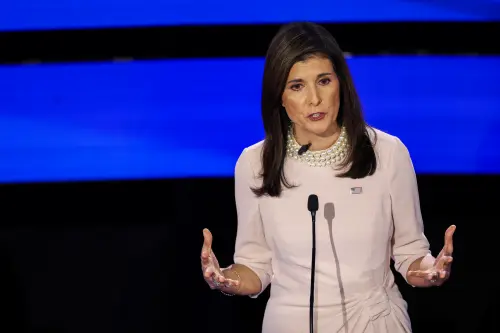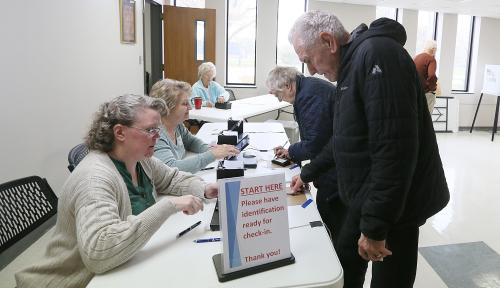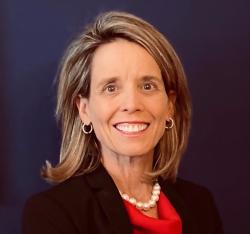This piece looks specifically at high-level personnel turnover in the first three years of the Biden administration. To keep up with current levels of turnover within the president’s “A-Team,” please see Brookings’s regularly updated tracker.
2023 was another challenging year for the president — tepid approval ratings, narrow margins in Congress, calls for impeachment, new and continuing military conflict abroad, and an economy struggling to regain its footing. Despite these challenges, relative stability in White House staffing continued to be a Biden administration hallmark, particularly when compared to the tumult in the Trump administration. In year three, the men and women who work at the most senior levels of the Executive Office of the President (EOP) continued their efforts with less turnover than in 2022, dropping from 35% (23 individuals) in 2022 to 23% (15 individuals) in 2023. Overall, three years of top staff departures stand at 65%, which ranks President Biden fourth among the seven presidents going back to Ronald Reagan and including George H.W. Bush, William Clinton, George W. Bush, Barack Obama, and Donald Trump.
This study focuses on staff turnover on the president’s 66-member “A Team,” which includes many of the most senior positions in the EOP. Given the breadth of responsibilities that modern presidents bear, the “A Team” includes some of the most influential, unelected individuals in our government. Knowing how long they stay in key positions tells us something about a president’s ability to instill loyalty among top advisers, might reveal dissention within the senior ranks, and may affect performance due to a successor’s “learning the ropes” in real time. While performance is likely affected by departures, studying turnover is not, by itself, a measure of performance. In short, this study sharpens our understanding of how the modern presidency operates by highlighting the tenure of senior presidential advisers.
Methodology and data
I define “turnover” as vacancies created through resignation, or firing, but also through promotion (lateral or otherwise), which also creates disruption entailed in filling a vacancy. Since each of these “A Team” staff members is a critical participant in presidential operations, each turnover may alter performance in various ways. A senior departure, for example, can cause additional junior departures because a principal’s staff may follow her to a new post, or an incoming principal may want to “clean house.”
I use the same data and research approach as I have in my 10 prior studies since 2018, most recently here. I relied on the “A Teams” for Presidents Reagan through Obama identified in the National Journal’s five “Decision Makers” editions from 1981 to 2009. At the start of the Trump administration, I partnered with FedScoop journalist Madison Alder. We sought to replicate the National Journal framework, which then became the basis for “A Team” listings for Presidents Trump and Biden. See here for additional details.
The bar chart shows that President Biden’s cumulative turnover after three years in office placed him in the middle of his six predecessors, with Trump’s cumulative turnover at the end of year three an outlier.
Moving beyond the aggregate figures, here are some telling snapshots of the 15 departures:
- Two of the departures occupied positions that required Senate confirmation (National Cyber Director, Chris Inglis and Chair of the Council of Economic Advisers, Cecilia Rouse). Confirming appointees in the current political environment is no small task, such that replacing these individuals requires far more resources than an appointee who does not need Senate confirmation.
- Six departees held the most senior title in the White House, Assistant to the President. On June 30, 2023, the Annual Report to Congress on White House Office Personnel identified 28 staff members as having this prestigious title (out of 524 positions listed). Assistants to the President who left the White House in 2023 included: Chief of Staff, Ron Klain; Domestic Policy Adviser, Susan Rice; Director of the National Economic Council, Brian Deese; Legislative Director, Louisa Terrell; Communications Director, Kate Bedingfield; and Director of Intergovernmental Affairs, Julia Rodriguez. Successors were cued up for these prized positions and there seemed to be little drama associated with the comings and goings. Nevertheless, turnover among the most senior staff in year three represented a stark contrast to the turnover that occurred in year two.
- Presidents’ third year often has included a shuffling of senior staff members from the White House to the reelection campaign, but of the 15 departures in year three, Julia Rodriguez was the only individual who fit that bill. She is currently the manager of the Biden-Harris reelection campaign.
- The Office of Legislative Affairs experienced significant “A Team” departures (Director Louisa Terrell and Deputy Directors Reema Dodin and Shuwanza Goff). Goff experienced a boomerang effect — she departed in February as Deputy Director (liaison to the House of Representatives) only to return in August to run the Office of Legislative Affairs.
- Two key departures cited above (Deese and Rouse) represented significant losses for the economic team.
Though one can only speculate on the causes of the 15 departures, one reason may be the increased (and inevitable) focus on reelection when, some former White House staff members contend, reelection politics trumps policymaking. Ever since President Nixon established an independent reelection organization (CREEP, The Committee for the Reelection of the President), the national party’s role in reelection planning has declined, and the White House has become more involved in campaign planning. Referring to the 1992 reelection campaign, Marlin Fitzwater, President George H.W. Bush’s press secretary, explained, “Within the White House there is less emphasis on issues, fewer decisions coming to the president. The President was distracted by the campaign…lots of travel…Maybe we should’ve abandoned the process of governing earlier. The reality is the White House pretty much comes to a stop.”1 “Shutting down” governing for the reelection campaign does not necessarily create an inviting climate for those happily immersed in the details of legislation or policy analysis. Also, “burnout” in the White House is real: Many of the 15 departing staff began working grueling hours when they joined the Biden campaign in spring of 2019. In short, some of the senior staff members departing in year three were reaching their fifth year with Team Biden.
Another key segment of senior presidential appointees includes the Cabinet secretaries in the 15 departments that are in the line of presidential succession. Whatever the fluctuations among the “A Team” in the EOP, the Biden Cabinet has experienced record-level stability compared to the six most recent administrations. George Condon of the National Journal recently reported that one had to go back 171 years, to the nation’s 14th president, Franklin Pierce, to find a more stable Cabinet. Only one Biden Cabinet member has departed, Labor Secretary Marty Walsh. (Note that my analysis of turnover relies on a strict definition of “Cabinet,” including only the 15 Cabinet secretaries in the line of presidential succession.)
Looking ahead to year four
If historical precedent holds, “A Team” turnover will likely decline next year. Additionally, Cabinet secretaries will likely hold steady barring any major scandal or public outcry for resignation. The difficult Senate confirmation process creates an incentive for incumbents to stay on the job rather than subject a replacement to the process, and an incentive for the president to discourage resignations. (See the ongoing quest to confirm Labor Secretary nominee, Julie Su. Her nomination and renomination for Labor Secretary have been nothing if not turbulent.)
-
Acknowledgements and disclosures
Special thanks to my colleague, Russell Wheeler, Nonresident Senior Fellow in Governance Studies, for incisive editing and helpful questions and comments.
-
Footnotes
- Kathryn Dunn Tenpas, “Presidents as Candidates: Inside the White House for the Presidential Campaign” (New York: Routledge, 1997, pp. 83-84).
The Brookings Institution is committed to quality, independence, and impact.
We are supported by a diverse array of funders. In line with our values and policies, each Brookings publication represents the sole views of its author(s).








Commentary
Staff turnover in year three of the Biden administration
January 20, 2024